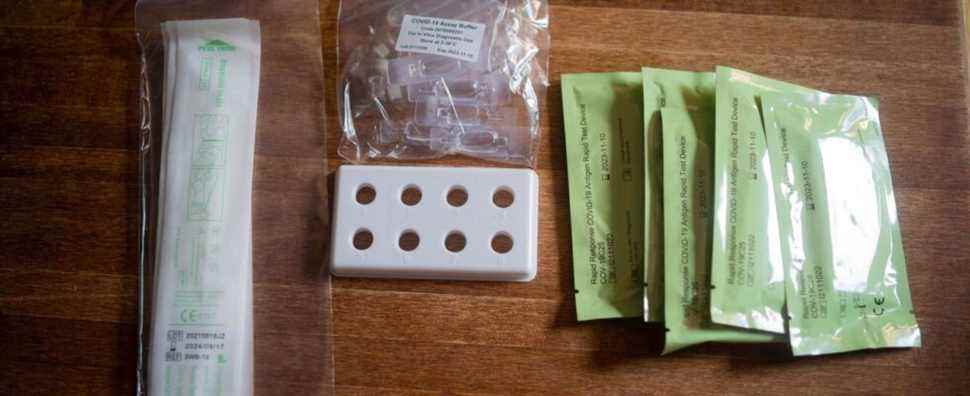N95 masks that detect COVID-19 in the breath of their user, a small pill that changes color on contact with the genetic material of a virus: technologies for detecting various diseases have been developing rapidly since the start of the pandemic, according to chemical engineering researcher Hamid Tali of Concordia University. But there is still a long way to go before reaching the ideal diagnostic tool, he notes after analyzing hundreds of studies on the subject.
The ideal detection tool, according to the World Health Organization, meets the criteria gathered under the English acronym ASSURED, that is to say that it does not cost much (affordable); is sensitive (sensitive), specific (specific), easy to use (user friendly) and fast (quickly); requires a minimum of equipment (equipment-free) and wants to be accessible (deliverable).
Fine-tune screening
“If we had very reliable tests that could be done anywhere and gave results in two minutes, it might not be necessary to impose confinements and closures. We could put in isolation only the infected people, ”said Mr. Tali.
To find out where the planet is in achieving this goal in relation to COVID-19, measure the scope of the tasks that remain to be accomplished and guide future research, Mr. Tali and a team of eight other experts of three universities analyzed near 600 scientific articles on the subject. The result was published in the journal Clinical Microbiology Reviews last May.
In total, about fifteen existing methods belonging to three different categories were thus scrutinized. The first category includes nucleic acid amplification methods, which detect the RNA of the virus. This is where we find the most reliable and precise techniques, such as the PCR test, used on a large scale in Canada. But they are more complex and require more equipment, so they are mainly used in the laboratory.
If we had very reliable tests that could be done anywhere and gave results in two minutes, it might not be necessary to impose confinements and closures.
“There are increasingly smaller, faster and easier to use devices in this category. We have seen progress since the start of the pandemic, and we could see more progress within a year, ”believes Mr. Tali, however.
Among the promising techniques in development, the researcher mentions a device designed by scientists from the Massachusetts Institute of Technology (MIT) and Harvard University. These are masks fitted with sensors that can detect COVID-19 in people wearing them within 90 minutes. They use CRISPR-Cas technology, which falls under the category of molecular RNA detection methods.
“Initially designed as a tool for genetic modification and first published in 2012, CRISPR-Cas found its application in biosensing in 2016. COVID-19 has significantly accelerated research into detection methods with CRISPR, and Food and Drug Administration in the United States has authorized the first emergency use of a diagnostic system using CRISPR,” explained Mr. Tali.
Different uses
The second category is that of antigenic tests, such as rapid tests that can be done at home. They detect proteins present in the structure of SARS-CoV-2. Since they’re less accurate, Tali points out they’re recommended to be used within 5 to 10 days of the onset of symptoms. Since the risk of false negatives is very real, it makes sense to repeat the test some time after the first result, he said.
“What is adequate in terms of frequency and time between the two tests is not yet clear,” says Mr. Tali, however.
The third category are tests that detect specific antibodies secreted by the human body when it contracts COVID-19. These techniques are not yet used for diagnostic purposes, since there is a delay before the body develops a detectable amount of antibodies.
“Serological immunological methods can be important in identifying the magnitude and duration of the antibody response, which helps to understand the effectiveness of vaccines and the relevant frequency of their use,” added Mr. Tali.
For his part, Mr. Tali is working on improving a method of detection using tablets that anyone could keep in their pocket. These methods use glucose polymers to encapsulate reagents. The tablets would be durable, inexpensive, and easy to use to detect a variety of targets, including infectious diseases, diabetes, and even pesticides in water.
“The user only needs to drop a pill into a liquid sample and wait for a color change,” explained Tali, who is doing this research at the Anbuhi Research Group lab at Concordia University.
Despite all these great advances, Mr. Tali does not believe that the perfect method will be on the market before the end of this pandemic. Fortunately, most of these systems can be adapted to detect new diseases. In the next pandemic, we will be ready, he believes.
This content is produced in collaboration with Concordia University.
